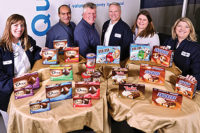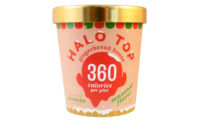You want to talk about multitasking? Consider this: the Kemps ice cream plant in Rochester, Minn., prepares 52 different ice cream mixes, runs multiple filling lines and makes an estimated 900 products for its own brand, co-pack and private label partners, and foodservice accounts. And it does this all day long, every day of the week.
Operations Manager Mike Hinrichsen calls the plant one of the largest ice cream facilities in the United States. The plant is nearly 219,000 square feet on 10 acres in downtown Rochester. The original plant was built in 1924 but over the years the owners have expanded it. In 1964 there was a freezer expansion; the hardening area was enlarged in 1981 and again in 2010. The production area was renovated and expanded in 1989; and a pelletized ice cream area was added in 2006.
Running a plant this size with so many products and so many customers is a complex dance. Based on what Dairy Foods saw during its tour of the facility, Kemps is dancing with the stars.
As in any manufacturing facility, sales forecasts drive production. That means the purchasing department needs to line up resources and the supply chain department has to make sure that the ingredients and packaging arrive on time. Then an operational group fine tunes the plan into a production schedule, Hinrichsen explained.
The ice cream plant is one of two Kemps dairy processing facilities in Rochester. A milk plant is on the other side of town. At the ice cream plant, tankers pull up to the two receiving bays to deliver dairy and nondairy ingredients. Dairy Farmers of America plants supply many of the ingredients. (DFA bought Kemps from HP Hood in 2011. See related article on page 32.) Condensed skim arrives from Plainview, Minn., and condensed whey from Zumbrota, Minn. Buttermilk comes from a plant in Greenwood, Wis. Rochester has three receiving lines for liquid sugar (fructose, sucrose and corn syrup); the sweeteners are stored in three 20,000-gallon silos.
Dairy ingredients are sent to the on-site lab where they undergo standard tests for components, total bacteria and other quality-control measurements.
A view from the bridge
The plant prepares 52 different mixes for frozen desserts and novelties. It makes ice cream, ice cream sandwiches, milk shakes and frozen yogurt. In a second-floor control room overlooking the processing area, operators keep track of the formulas, mixes and the filling lines. Pasteurization data from the milk processing equipment is recorded on the paper disks.
Ingredients for the ice cream mixes are metered into batch tanks, and the volume is verified by load cells. This “belt and suspenders” approach assures that recipes are assembled accurately. Raw components in the tank are pumped to the powder room where emulsifiers, stabilizers, cocoa powders and other dry ingredients are blended. Then the mix is pumped back to the batch tanks.
Depending on what it is making, Kemps will use a high-temperature/short-time pasteurization process or a slower vat pasteurization process. Some ice cream mixes are balanced to the HT/ST pasteurization system. Other mixes are processed in one of the vat pasteurizers which heats the mix to 180 degrees and holds it for 30 minutes. These are used for homemade French vanilla, chocolate and strawberry ice creams, as well as for pasteurizing the revels. Yogurt cultures for frozen yogurt products are vat pasteurized and the cultures grow to the required pH.
Nonstop filling
A transfer room outside of the filling room is where supplies are moved off wooden pallets and onto plastic pallets for food safety and quality control reasons. Materials come from an on-site dry warehouse and an off-site warehouse for packaging and supplies. Kemps uses lot-code tracking in order to trace what is being delivered and used.
After processing, the mix is pumped to flavor vats in the filling room. A computer schedule shows the sequence for adding flavors and colors (which are added manually). Mix is then pumped from the vats to the freezers. Kemps hooks up one pump to two flavor vats in order to keep a continuous supply of mix flowing into the freezers. As one vat empties, the pump switches over to the other.
Just as the batch tanks in the processing room have load cells, so do the ingredient feeders in the filling room. Revels also go through the feeder. A computer matches the speed of the freezer and filler to keep the ingredients feeding into the fillers at the proper rate.
Among the products Kemps was making on the day Dairy Foods visited were bricks of Neapolitan ice cream, ice cream sandwiches and frozen milkshakes in plastic cups (called malt cups) for foodservice accounts. The processor also makes a pelletized ice cream product sold in supermarkets. The seasonal item was not in production during the magazine’s visit.
Electronic signs above each work station flash updates on the production. Equipment operators know exactly how much ice cream they have produced and how much more needs to be run to meet the day’s target. Operators use hand-held scanners to input production information such as down time and scrap by package size. The plant tracks these statistics through its factory report IT system. It looks at unplanned downtime events, scrap, turn-around times, sanitation and other measurements.
Like any plant manager, Hinrichsen strives to reduce down time. The company runs a lot of different products on shared lines. That means when there is a changeover, the machine is not running; thus a loss of productivity. “We have had to get much better at controlling changeovers,” he said.
Waste and spoilage is wheeled away in color-coded carts that denote allergen or nonallergen status. Kemps’ liquid waste is sold to a company that uses it to produce animal feed products.
Some of the ice cream packaging is assembled in a staging area in an upstairs room over the filling floor. Kemps moved this operation upstairs in order to free up space in the filling room. Scrounds are built on a form and conveyed to the room below. An operator dumps lids into a bin and they are unscrambled and conveyed in the proper orientation to the fillers.
As the products leave the filling room, they move by conveyor belts into the packaging room (or “wrap room” in Kemps terminology). There is a metal detector on every line. A printer prints a plant code and date on the bottom of every package.
Kemps installed an enhanced vision inspection system on three lines. These systems ensure that the lids match the containers (for example, both the lids and containers say “chocolate”). After a tamper-evident band is applied, the packages move to a secondary packaging area. Inverters, which flip over every other package, have helped Kemps reduce damage to the cartons. Novelties are put into boxes and cartons are shrink-wrapped on corrugate.
The packages move up spiral conveyors to the hardening room where temperatures reach minus 40 degrees. The facility has three hardening systems: a roller bed, a tri-tray and a spiral hardening freezer. It takes five hours to cycle through the tri-tray hardener. The 3-gallon foodservice tubs and the ice cream sandwiches are stored in the roller bed system. Other products go into the spiral freezer where the temperature is the coldest. Kemps uses manual palletizers in the freezers because the conditions there are too harsh for automatic machines. But the company is looking for automated palletizers that can withstand the conditions in the freezer.
Test and verify
On the day of Dairy Foods’ visit, a technician in the on-site quality laboratory was testing all the raw materials the dairy processor had received in the last year. The testing regimen is part of the company’s good manufacturing practices, said QA Manager Natasha Banton.
The lab runs micro analysis, allergen verification, phosphatase analysis, Brix testing, DMC and chemical analysis (mainly fat, total solids, pH and TA) on all raw ingredients. The lab also tests in-process items and finished products for various food safety and quality attributes. Lab techs test all work in process for components (butter fat, total solids). They take samples from the flavor vats and the process tanks. A sample from every production batch is collected at startup, flavor change (or every six hours) and at the end of day.
The organoleptic evaluation focuses on flavor, texture and appearance. It is performed by production team and quality lab team members. They cut the finished product and inspect it for the proper distribution of revels and inclusions.
The plant is SQF Level 3-certified. It falls under the jurisdiction of the Minnesota Department of Agriculture, Dairy and Food Safety Division, and the federal Food and Drug Administration. The plant is visited annually and auditors spend three days evaluating the food safety and food quality systems. Kemps spells out its supplier certification program in its Supplier/Co-Packer Quality Systems manual.
“Vendors are required to submit documentation that demonstrates their compliance to certification guidelines,” Hinrichsen said.
A HACCP plan ensures that all risks (biological, chemical, physical and radiological) are evaluated at each step of the ice-cream-making process. The critical control points are monitored continuously and reviewed by team members.
“Our plant has established a Food Quality Plan that was designed using the seven principles of HACCP,” Hinrichsen said. This plan evaluates food quality risks instead of food safety risks. There are quality parameters that are monitored on incoming ingredients, in process product, finished product, hardening systems and load-out trailer requirements, he said.
Managing resources
Kemps uses a single-use CIP process. In the CIP room are four units for pasteurization and two for raw. The company installed a new epoxy floor in this room in December 2013. A capital expenditure project for 2014 is the replacement of some of the ice cream fillers. The new units will add speed to the production lines, said Vice President of Operations Bob Williams.
As the company looks at new equipment, it seeks to keep conveyors at waist height to limit ergonomic issues. Kemps also analyzes equipment to ensure there are no safety concerns before it is installed. Cross-department safety teams also have a hand in ergonomic issues. The team was considering instituting a stretching and exercise program to warm up employees before they start their shifts.
Like all good dairy processors, Kemps is looking at how it uses renewable and nonrenewable resources. A waste water reduction project also resulted in a reduction in lost finished product and ingredients. Kemps drew on the expertise of a team of engineers from the Minnesota Technical Assistance Program (known as MnTAP) at the University of Minnesota, St. Paul. The team found that Kemps was flushing a lot of by-products down the drain, resulting in high BOD (biochemical oxygen demand) loadings in the wastewater. After rebuilding the by-product collection system, the plant saved more than $72,000 in lost product and ingredients.
While working on the by-products issue, the MnTAP team found additional opportunities to save money and resources. Kemps added water meters to two cooling towers and in the power room. Installing chemical feed pumps to the vat pasteurizers allowed for accurate monitoring and use of a more effective cleaning chemical.
This plant holds an important role in the company. Kemps CEO Greg Kurr has called ice cream and frozen yogurt “strategic pillars” in Kemps’ national growth plans. Operations Manager Hinrichsen choreographs the plant’s employees who support that plan every day around the clock. It is quite a dance.
At-A-Glance
Kemps ice cream plant, Rochester, Minn.
Year built: 1924. Expansions and renovations in 1964, 1981, 1989, 2006 and 2010.
Size of plant: 219,000 square feet on 10 acres
Products made: ice cream (including natural, reduced fat and no sugar added); ice cream sandwiches; sherbet; frozen yogurt (fat free, low fat and no sugar added fat free); malt cups (milkshakes); Ittibitz (pelletized ice cream). Formats are 6 ounces; 10 ounces, pints, quarts, scrounds, pails and 3 gallon containers.
Warehouse:19,216-square-foot dry warehouse with two receiving bays. 27,682-square-foot frozen warehouse with 900 pallet spaces and a three-bay loading dock. Outside warehouses for packaging and an outside frozen storage facility.







